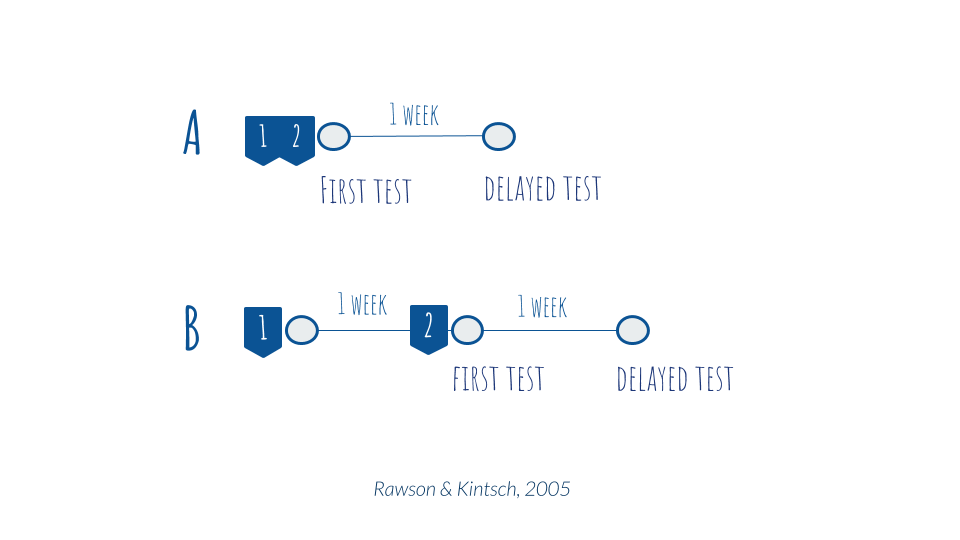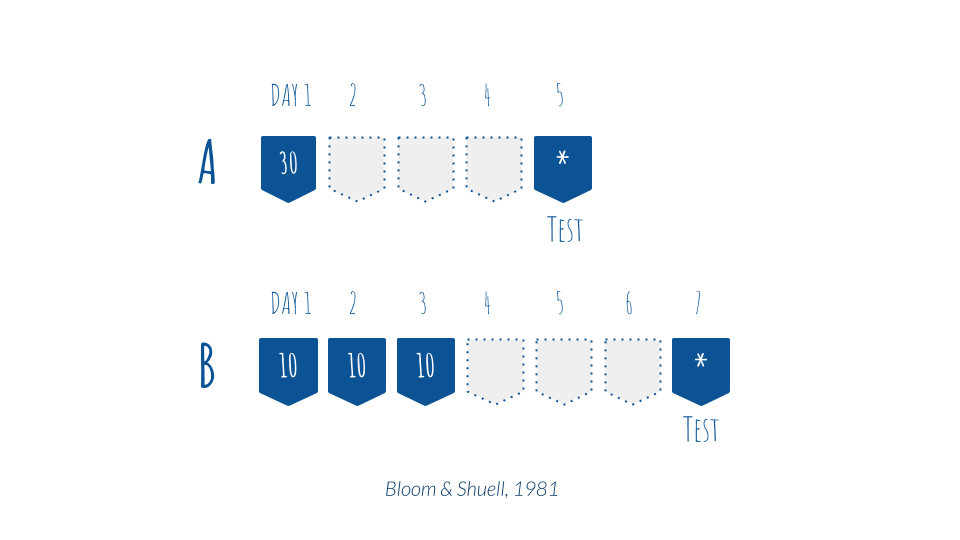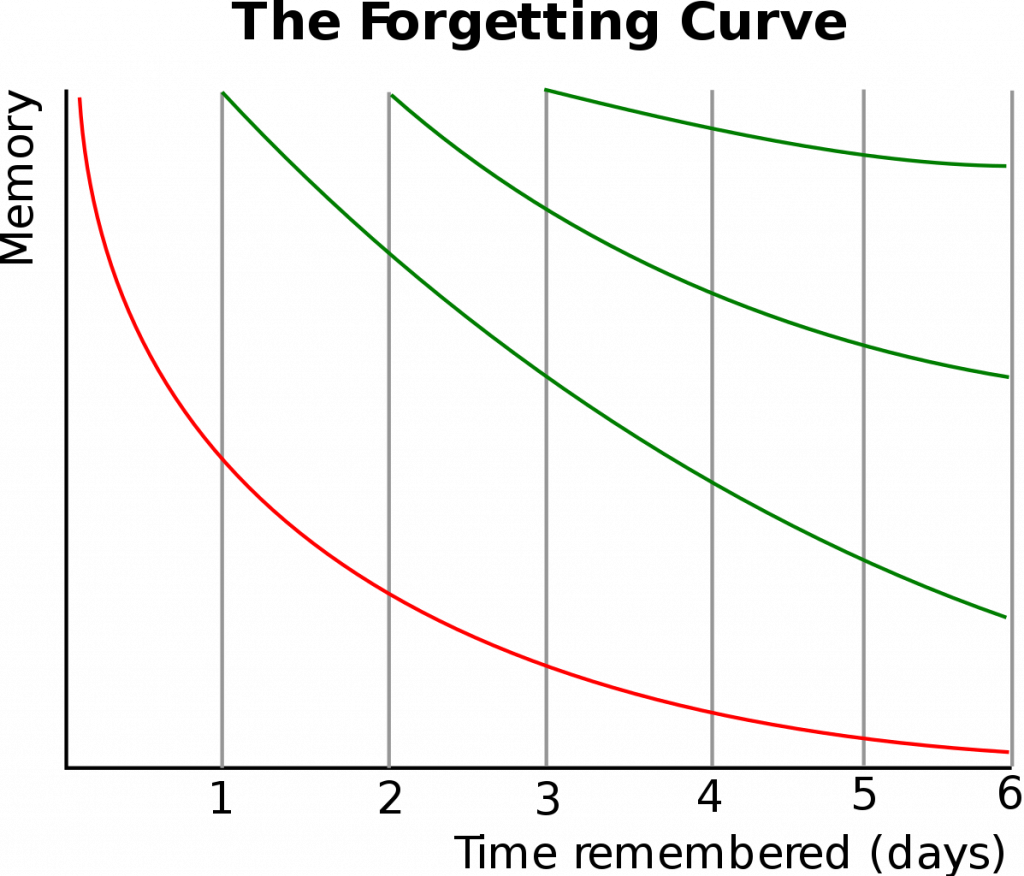21
Spacing Effect and Distributed Practice
How should learning be scheduled? The key concept to know is the spacing effect which describes “the robust finding that long-term learning is promoted when learning events are spaced out in time, rather than presented in immediate succession” (Vlach & Sandhofer, 2012). The spacing effect has been demonstrated in hundreds of studies since 1885 including the learning of facts, concepts, language, science, pictures, prose, and skill and motor learning such as typing, complex video games, and surgical skills (Roediger III & Pyc, 2012). Vlach and Sandhofer (2012) also found that the benefits of distributed practice are not limited to memory for specific information (e.g. facts or lists of words). Distributed practice also “promotes the acquisition and generalization of educational concepts.” Distributed practice is the learning strategy that takes advantage of the spacing effect by deliberately spacing out learning over time. Below are two studies that demonstrate the benefits of distributed practice (i.e. the spacing effect).
Study 1: Massed vs. Distributed Practice (Rawson & Kintsch, 2005)
In the study by Rawson and Kintsch (2005), students read a long text and took two tests – immediately after the learning session and one week after the last learning session (e.g. the last time the students read the text). Group A read the text twice in a row (same day). Group B read the text twice with one week in between readings. Both groups spent the same amount of time reading the text. The massed group (Group A) performed better on the immediate test. The distributed group (Group B) performed much better on the delayed test. Often, the results of immediate tests can trick us into believing that massing practice or cramming, which is the student version of massed practice, is a more effective strategy.

Study 2: Massed vs. Distributed Practice (Bloom & Shuell, 1981).
High school students were taught French vocabulary and given a test 4 days later. Group A was taught in one 30-minute session. Group B was taught in three 10-minute sessions on successive days. There was a 35% advantage for distributed (Group B) over massed practice (Group A) – on the test taken 4 days later. This advantage was only due to changing how the learning was scheduled.

In sum, how we schedule learning activities matters. If we just want students to know the material for an exam, we can encourage massed practices. However, if we want them to keep what they’ve learned for a longer period of time then distributing their practice is critical. Moreover, it has been shown that “when retention intervals are measured at a week or greater, studies show that distributed practice nearly doubles recall performance (Cepeda et al., 2006).” So, with a slight alteration to how we schedule the presentation of important content, independent of how students study on their own, we can both improve student rates of learning and model to students a fundamental lifelong learning strategy.

References
Spacing Effect and Distributed Practice
- Vlach, H. A., & Sandhofer, C. M. (2012). Distributing learning over time: The spacing effect in children’s acquisition and generalization of science concepts. Child development, 83(4), 1137-1144.
- Cepeda, N. J., Pashler, H., Vul, E., Wixted, J. T., & Rohrer, D. (2006). Distributed practice in verbal recall tasks: A review and quantitative synthesis. Psychological bulletin, 132(3), 354.
- Roediger III, H. L., & Pyc, M. A. (2012). Inexpensive techniques to improve education: Applying cognitive psychology to enhance educational practice. Journal of Applied Research in Memory and Cognition, 1(4), 242-248.
- Rawson, K. A., & Kintsch, W. (2005). Rereading effects depend on time of test. Journal of Educational Psychology, 97(1), 70.
- Bloom, K. C., & Shuell, T. J. (1981). Effects of massed and distributed practice on the learning and retention of second-language vocabulary. The Journal of Educational Research, 74(4), 245-248.
Additional reading on the spacing effect and distributed practice
- Stahl, S. M., Davis, R. L., Kim, D. H., Lowe, N. G., Carlson, R. E., Fountain, K., & Grady, M. M. (2010). Play it again: The master psychopharmacology program as an example of interval learning in bite-sized portions. CNS spectrums, 15(8), 491-504.
- Bahrick, H. P. (1979). Maintenance of knowledge: Questions about memory we forgot to ask. Journal of Experimental Psychology: General, 108(3), 296.
- Hopkins, R. F., Lyle, K. B., Hieb, J. L., & Ralston, P. A. (2016). Spaced retrieval practice increases college students’ short-and long-term retention of mathematics knowledge. Educational Psychology Review, 28(4), 853-873.
- Rawson, K. A., & Dunlosky, J. (2011). Optimizing schedules of retrieval practice for durable and efficient learning: How much is enough?. Journal of Experimental Psychology: General, 140(3), 283.
- Vlach, H. A., Sandhofer, C. M., & Bjork, R. A. (2014). Equal spacing and expanding schedules in children’s categorization and generalization. Journal of experimental child psychology, 123, 129-137.
- Xue, G., Mei, L., Chen, C., Lu, Z. L., Poldrack, R., & Dong, Q. (2011). Spaced learning enhances subsequent recognition memory by reducing neural repetition suppression. Journal of cognitive neuroscience, 23(7), 1624-1633.
Media Attributions
- EN Illuminated eBook Graphics (22)
- EN Illuminated eBook Graphics (23)
- 1197px-ForgettingCurve.svg
